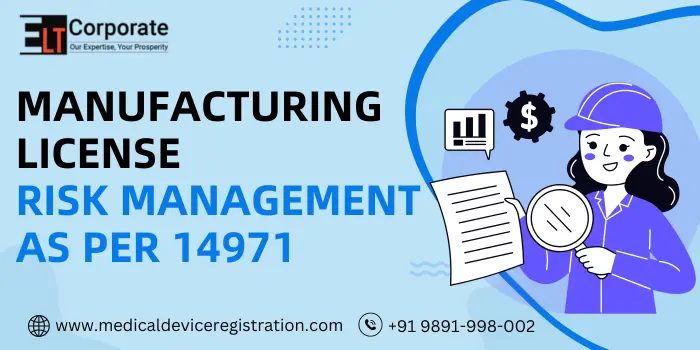If you are eager to know what Manufacturing License Risk Management is as per 14971, here is the detailed answer to your query. Manufacturing License Risk Management means safety and ensuring the Company’s profitability. Now just the article and know all the details like how to get it, what is Manufacturing License risk management and so on.
What is an MDR license?
MDR refers to Medical Device Reporting, a guideline that requires producers, shippers, and gadget client offices to report specific device-related issues to the FDA. MDR aims to help doctors, healthcare providers, producers, and consumers understand a medical device’s safety and efficacy after it’s been put on the market.
What is the Medical License Risk Management Process According to ISO 14971?
ISO 14971 is a global standard that outlines a risk management process for medical devices throughout their life cycle. The method determines dangers, estimates and evaluates risks, controls risks, and monitors the effectiveness of controls.
How to Get a Manufacturing License Risk Management for Medical Devices?
To get a Manufacturing License for class C and Class D medical devices, The manufacturer must submit an online application using Form MD-7 through the Central Licensing Authority of the Ministry of Health & Family Welfare in the Central Government to permit a medical device manufacturing License.
Medical Device & IVD Device Risk Management File:
- Reference & Design File
- Risk Management Plan
- Reference of PMS Plan
- Risk Management Report
- Risk Policy
Risk Management for Medical Devices includes Stages:
Production and Post-Production Activities
Risk Management Review
Evaluation of Overall Residual Risk
Risk Evaluation
Risk Control:-
- Risk Control Option Analysis
- Benefit-Risk Analysis
- Implementation of Risk Control Measure
- Completeness of Risk Control
- Residual Risk Evaluation
- Risk arising from risk control measures
Risk Analysis:-
- The Risk Analysis process
- Intended use and reasonably foreseeable misuse
- Identification of characteristics related to the safety
- Identification of hazard and hazardous situation
- Risk Estimation
Residual Risk
If the manufacturer determines that risk reduction is not practicable during the risk control option analysis, a benefit-risk analysis of the residual risk must be conducted. After implementing risk control measures, the manufacturer shall evaluate the residual risk according to the risk acceptability criteria defined in the risk management plan. If the residual risk is deemed unacceptable based on these criteria and further risk control is not feasible, the manufacturer may collect and review data and literature to assess whether the benefits of the intended use outweigh the residual risk.
If the overall residual risk is acceptable, the manufacturer must inform users of significant residual risks. This information should be included in the accompanying documentation to ensure the disclosure of these residual risks.
What is Manufacturing License Risk Management in GMP?
It is a necessary part of good manufacturing Practices (GMP) and essential to ensuring patient safety and product quality. The primary target of QRM is to recognize potential risks and develop strategies to limit or eliminate them.
How to Conduct FMEA for Medical Devices?
Failure Modes and Effects Analysis (FMEA) is a process that can evaluate risk in medical devices by recognizing potential failure modes and their effects. The FMEA process is mentioned below:
- Define the scope
- Assemble a team
- Describe the process
- Identify failure modes
- Determine severity
- Gauge likelihood
- Prioritize
- Document effects
- Identify causes
What are Various Method for Risk Analysis?
Risk analysis is a multi-step process that helps identify and analyze potential risks that could adversely affect them later on. It also helps enterprises with understanding the financial implications of these dangers and what steps they can take to moderate or dispose of them.
Conclusion
In Conclusion, managing risks for manufacturing medical devices is crucial for ensuring safety and profitability. The ISO 14971 standard gives a comprehensive process for identifying, assessing, controlling, and monitoring risks throughout the device’s life cycle. Getting a manufacturing license includes presenting an application and following explicit systems to guarantee consistency with wellbeing guidelines. Risk management comprises stages like production, post-production, and various evaluations to ensure all risks are controlled and acceptable. Good Manufacturing Practices (GMP) are fundamental for maintaining item quality and patient security. Apparatuses like Failure Modes and Effects Analysis (FMEA) help recognize and relieve possible disappointments in medical devices.
What is FMA Fullform?
Failure Mode and Effect Analysis is the full form of FMA.
How Does ISO TR 24971 Apply to ISO 14971?
ISO/TR 24971:2013 gives guidance in solving specific areas of ISO 14971 while implementing risk management.

